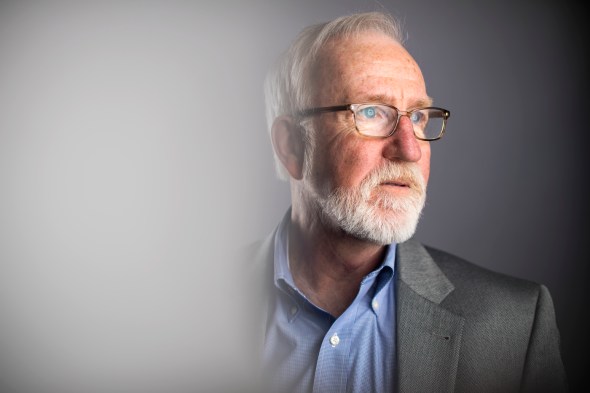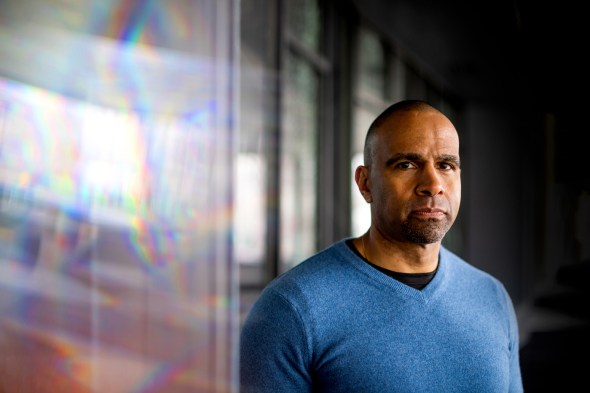Two years after George Floyd’s murder, has anything changed in policing?

Today, exactly two years after the murder of George Floyd, President Joe Biden is expected to sign an executive order on federal policing reform.
According to the New York Times, the order will broadly direct all federal agencies to revise their use-of-force policies, establish a federal accountability database for officers who have been fired for misconduct, and incentivize state and local law enforcement to ban or restrict chokeholds and no-knock warrants.

Change does not come easy for police departments, criminal justice professor Jack McDevitt said. Photo by Adam Glanzman/Northeastern University
The order, which has been in the works since police reform legislation failed to pass through the Senate last year, also limits the transfer of military equipment to law enforcement agencies.
But two years after former Minneapolis police officer Derek Chauvin killed Floyd by kneeling his neck for more than nine minutes, the supposed “reckoning” heralded by Floyd’s murder has yielded far less change than many had hoped.
Jack McDevitt, professor of the practice in criminology and criminal justice, said that changing police departments is often compared to bending granite—and for good reason.
“They’re very hard to change because they’ve got longstanding policies and procedures, they’ve got unions, they’ve got all variety of things that make it difficult to change,” McDevitt said. “But I do think I’m seeing a conversation about the need to change more widespread and more immediate than I’ve seen in the past.”
“One thing that’s happened that is positive is that police departments are less often in denial that there is a problem,” McDevitt added. “They know there’s a problem; where there’s been less progress is dealing with the problem and trying to think of what strategies will do that.”
Departments across the country have been either slow to implement change or encountered roadblocks. Even as some departments have tried to discipline or remove officers accused of misconduct, police unions have remained a solid barrier against reform, The New York Times reports.
“We’re all about trying to discipline officers or even remove officers that are worthy, and we’ve run into barriers ourselves in trying to do that over the years, with unions and civil service and things like that bringing back officers when we’ve tried to remove them,” Roy Vasque, chief of police in Lawrence, Massachusetts.
In the aftermath of Floyd’s murder, activists and civil rights leaders nationally rallied around calls to defund the police. In response, some communities took action, reducing police funding and funneling resources toward social service agencies and mental health supports.
However, in 2021, as violent crime rose nationwide, many of those same communities reversed course and increased their police budgets. Biden recently encouraged states and localities to spend their remaining American Rescue Plan Act funds on adding more police officers.
Conversations around bodyworn cameras and citizen police oversight boards quickly rose to the surface after Floyd’s murder. State legislators and local politicians took a renewed look at duty to intervene, de-escalation training, and no chokehold policies.
But McDevitt argued that real reform is about more than policies and procedures. At the time of Floyd’s murder, the Minneapolis Police Department had chokehold and duty to intervene policies, yet Chauvin put Floyd in a more than nine-minute chokehold as his fellow officers watched.
“That didn’t work, so what really needs to change is the culture of police,” McDevitt said. “… I think the way you change the culture is you get different eyes on what the police do, and one of them is these oversight boards, others are bringing police officers into the job who don’t look like white males, who are female or people of color or have different experiences with the police to draw on.”
The concept of “successful policing” requires a community-focused approach that that moves departments beyond the current concept of community policing, where administering police services is the core value, and into community building, Michael Davis, Northeastern’s chief of police, said.

Michael Davis, Vice President Campus Safety and Chief of Police. Photo by Matthew Modoono/Northeastern University
“There’s always this closed book thinking that, ‘We know how crime is reduced and let us be the experts,’” Davis said. “… Yes, we are the officials assigned to public safety, but the community are the experts.”
“Although arrests are necessary at times, if you ignore the community building aspect of it and dealing with the conditions that contribute to crime and disorder, then you’re just going to engage in this activity in a cyclical way,” Davis added.
Davis began his career as an officer in Minneapolis’ Third Precinct, the same precinct that Chauvin worked in. He served 16 years in Minneapolis, before, in 2008, becoming chief of police in Brooklyn Park, Minn. As a police practice consultant for the U.S. Department of Justice’s reviews of the fatal shootings in Ferguson and Cleveland, Davis has been at the forefront of reform.
During his time as chief in Brooklyn Park, both violent crime and arrests decreased. According to Davis, it was the result of collective action at every level of government.
“It’s really what success in policing looks like, and I made it clear to the city council when I started [in Brooklyn Park] in 2008 that we’re trying to work ourselves out of a job,” Davis said. “What we’re trying to do is build the level of connectivity between not just the officers and the community but between the community embers writ large, and we know that that is central to public safety in any context.”

Katie Sandson, program director for the Racial Redress and Reparations Lab, says that there has been some progress toward reparations, but it is not enough. Photo by Matthew Modoono/Northeastern University
Chauvin was found guilty of murder last year, but since 2020, the calls for justice have expanded beyond individual cases of police brutality to include a broader focus on reparations and restorative justice.
The fight for reparations for African Americans is not new. The H.R. 40 bill, which aims to create a federal reparations and remediation strategy, has been bandied about in Congress since the 1980s. But according to Katie Sandson, an attorney at the Civil Rights and Restorative Justice Project and program director of the Racial Redress and Reparations Lab, the events of 2020 have reignited the conversation around racial remediation and even produced some results. In 2021, Evanston, Illinois, and Asheville, North Carolina, put money toward reparations policies and H.R. 40 made it out of committee for the first time. But even now, change is slow.
“There have been a lot of bills proposed and introduced that haven’t passed. Even fewer are at the stage already where they’re implementing remedies,” Sandson said. “There’s a long way to go, but I do think there’s momentum and there’s been a wave of [proposed] legislation in the last few years.”
For media inquiries, please contact media@northeastern.edu.






